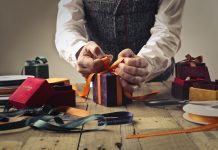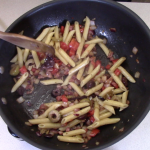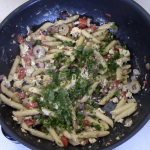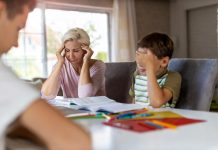By Chris Watson
There are things in the cooking that, no matter how hard we try, grow too large for a single meal. One of the biggest culinary culprits to get out of hand is pasta. This cooking workhorse has a tendency to grow, no matter how well we plan. Pasta has the honor of being described with words like “heaps” and “mounds”. When we live solo or in pairs that tends to take that food arrow out of our quiver. It shouldn’t. There are simply too many great, healthy pastas to just skip them because we think, from our youth, that pasta is always to much.
Sizes, Shapes, Colors, Oh My…
One of the blessings of pasta is that it comes in so many varieties and shapes. That is its charm. The problem with all that variety is figuring out how much to cook. Measuring fettuccine verses measuring elbow macaroni seems like two mutually exclusive tasks. For long pasta many want you to use diameter. Small shapes lend themselves to a measuring cup. But there is one way all pasta, regardless of its shape, can be easily measured and that is by weight.
When cooking for one or two splitting up larger commercial quantities is a common task and splitting by weight using a scale is a good option. Small kitchen scales are readily available in most mega

stores and kitchen shops. For our size household you really don’t need a very big or sophisticated scale. No matter which scale you choose it is worth the investment. They come in handy when trying to portion ingredients that are measured by weight, like cake and brownie mixes or boxes of pasta.
A word about pasta in general. We could do an entire documentary on types of pasta and how to cook it. Suffice it to say that besides the usual, white flour pasta of our youth there are a variety of higher fiber, colorful, higher protein pastas on the market that are amazing products. There is also a rapidly growing selection of alternative pastas made from things like beans, lentils, and alternative flours, with varying degrees of health benefits, textures, and even quality. The only way to find out which you prefer is to experiment. Fortunately, pasta is cheap, so experimenting is both affordable and interesting.
How much pasta do you need? Well, most pasta makers recommend about 2 oz of dry pasta per person. This is where the scale comes in. Just put a container (or paper towel) on your scale and zero it out. Then measure the amount you think you will want in ounces. It is just that easy. No guess work.
Boil, Salt, Drain…That’s It
Cooking pasta is very easy. What you need a large pot of boiling water and the pasta. Yes, you should salt the water…it makes the final product more flavorful. In my opinion, no don’t put oil in the water. Oil is used to reduce or prevent foaming. The easiest way to do that is to use a large pot and leave plenty of room. I almost

always cook the pasta to the low end of what is recommended for the product. First, it will continue to cook a bit as you remove it from the pot and drain it. Second, it won’t turn mushy when you add sauce or, if you have leftovers, use it a second time. Finally drain your pasta. I don’t recommend rinsing or putting oil on it. I place the strainer over the hot pan and put a lid over the strainer to help keep it warm.

Pasta is most commonly packaged between 12 and 16 oz, depending on the maker. Some of these pastas even have aggravating number of servings, like 6.5. Since we are now measuring by weight we shouldn’t have too many leftovers. However, if we do there is one dish that will use up pasta and make a great, comforting meal. Pasta carbonara, which is just a fancy way of saying eggs and pasta.
Pasta Carbonara
- 2 oz dried pasta like penne or spaghetti
- 2 oz bacon or pancetta
- 2 eggs beaten
- ½ small onion, diced
- 1 clove garlic, crushed
- ¼ cup each chopped olives, roasted red peppers, and/or sun dried tomatoes (any or all, optional)
- ½ to 1 cup zucchini, yellow squash, peppers or mushrooms (any or all, diced and optional)
- Salt, black pepper, crushed red pepper, dried basil, dried oregano to taste
- Chopped Parsley (optional)
- Fresh Grated Parmesan or Romano cheese
- Boil pasta to the low end of the cooking time recommended. Drain but do not rinse.
- In a hot pan render the bacon or pancetta
- Add onions to the and any seasonings and sauté until translucent
- Add any raw vegetables and lightly sauté
- Add and olives, peppers, or sun dried peppers and cook until heated through
- Add pasta and sauté until heated through
- Add eggs and cook until the eggs are set
- Finish with parsley and cheese
Pasta carbonara is just a spin on Italian stir fry. As with all stir fry’s the possibilities for ingredients are endless. The most popular is to use a small amount of bacon (2 oz) or pancetta and render that in the bottom of the pan. Then the dish always has at least onions and garlic. You can also add other vegetables like zucchini, summer squash, and mushrooms. Then feel free to add olives, sun dried tomatoes, and roasted red peppers. Finish with fresh parsley and top with cheese if desired.
Don’t hesitate to experiment with other flavors for this dish. One could easily skew Pasta Carbonara “American” by using ham, onions, and green or red peppers then top with Cheddar cheese (think Denver omelette). How about Tex Mex( chorizo, jalapenos, Monterey Jack cheese), or Asian….like omelettes or frittatas almost anything goes.

Even with our smaller size household we shouldn’t be afraid of pasta. It is possible to cook enough for one or two. Nor should shy away from pastas if we are looking for less refined and processed grains. There are simply too many good, healthy pastas on the market today to take them completely out of our diet. So welcome back an old, meal stretching friend, pasta. You will be glad it is back in your kitchen.















